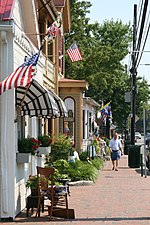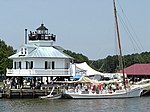The Saint Michaels Historic District encompasses the historic center of Saint Michaels, Maryland. The town, which has about 1,000 permanent residents, is located on a tributary to the Chesapeake Bay on the Eastern Shore of Maryland. After over 100 years as a center for trade and shipbuilding, the community was incorporated as a town in 1805. Shipbuilding peaked in 1820, and the town's economy became focused more on oyster and seafood collection and packing. In the 1970s, the town transitioned to tourism.
In the original 1986 nomination form, the Saint Michaels Historic District consisted of 362 buildings, sites, and structures. Sixty of the buildings were noncontributing. Many of the structures were originally constructed in the 19th century, and used the Federal, Gothic Revival, or Italianate architectural styles. The entire town has a 19th-century appearance, and much of the Historic District can be observed by walking. The homes that contribute to the Historic District are privately owned, but many have been converted into bed and breakfasts.
The Chesapeake Maritime Museum is located along the Miles River and St. Michaels Harbor, in the northeast corner of the Historic District and further north. It features Chesapeake Bay exhibits such as ship building and oystering. The small Saint Michaels Museum is located within the Historic District at Saint Mary's Square. It focuses on 19th century Saint Michaels, and conducts walking tours of the Historic District. Talbot Street (Maryland Route 33) is the major street in Saint Michaels, and runs north–south through the Historic District. The street is lined with shops and restaurants housed in 19th century buildings.




